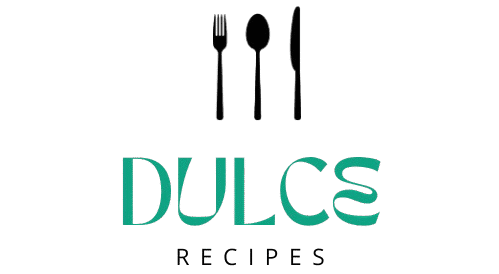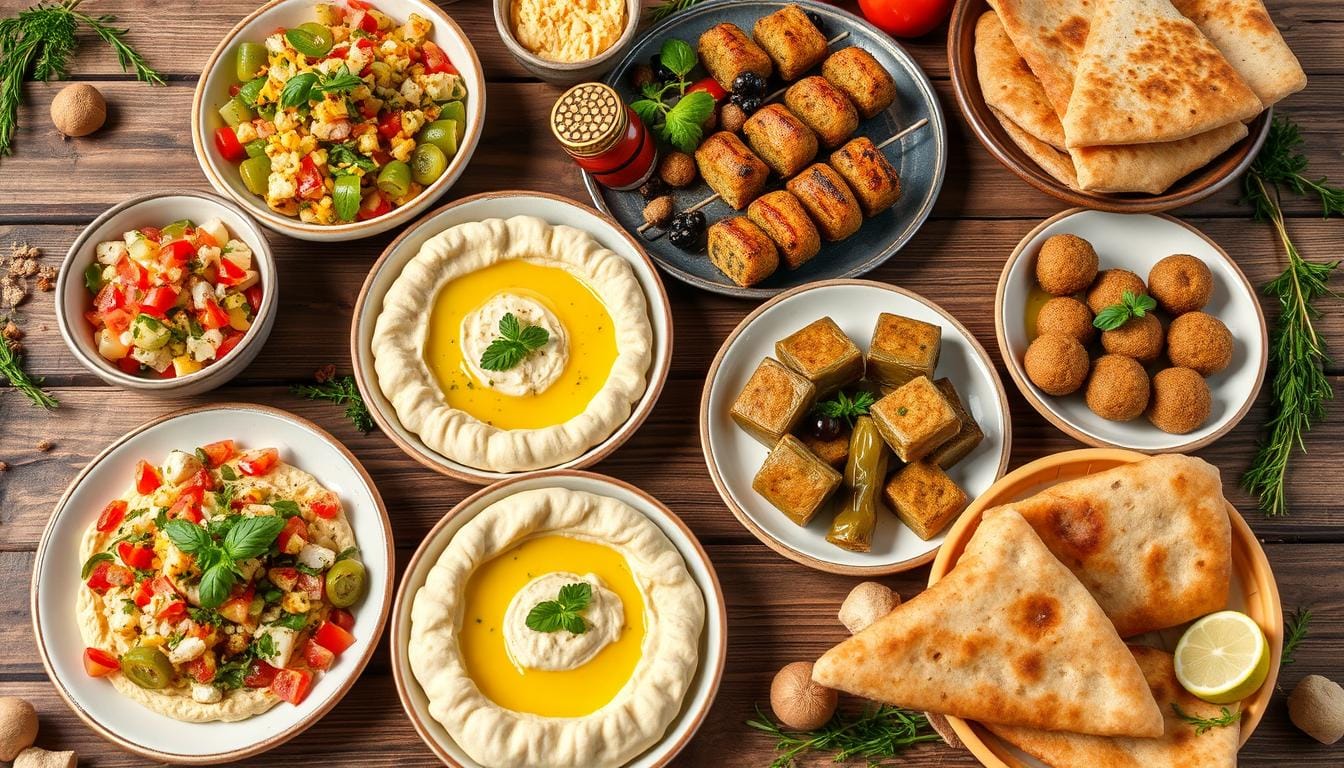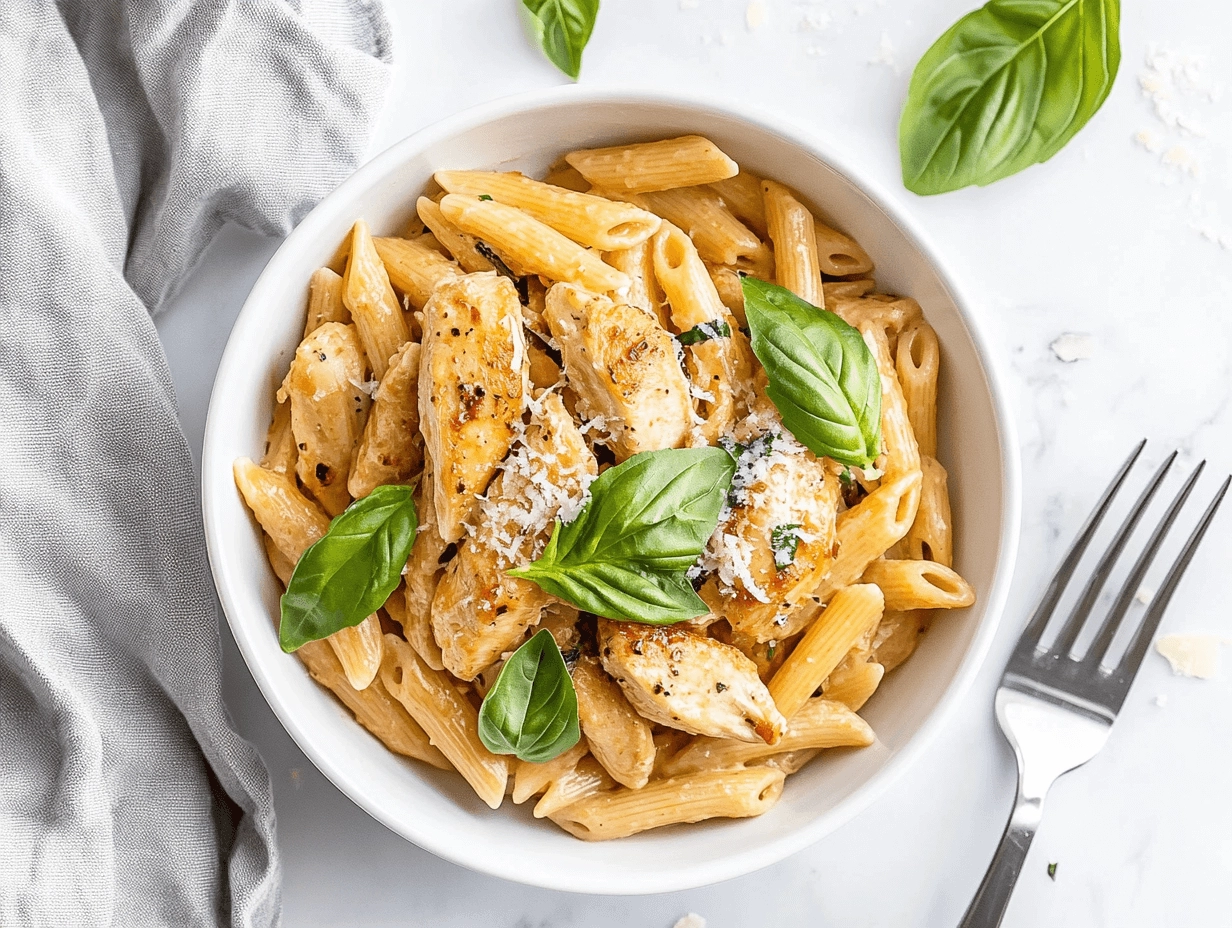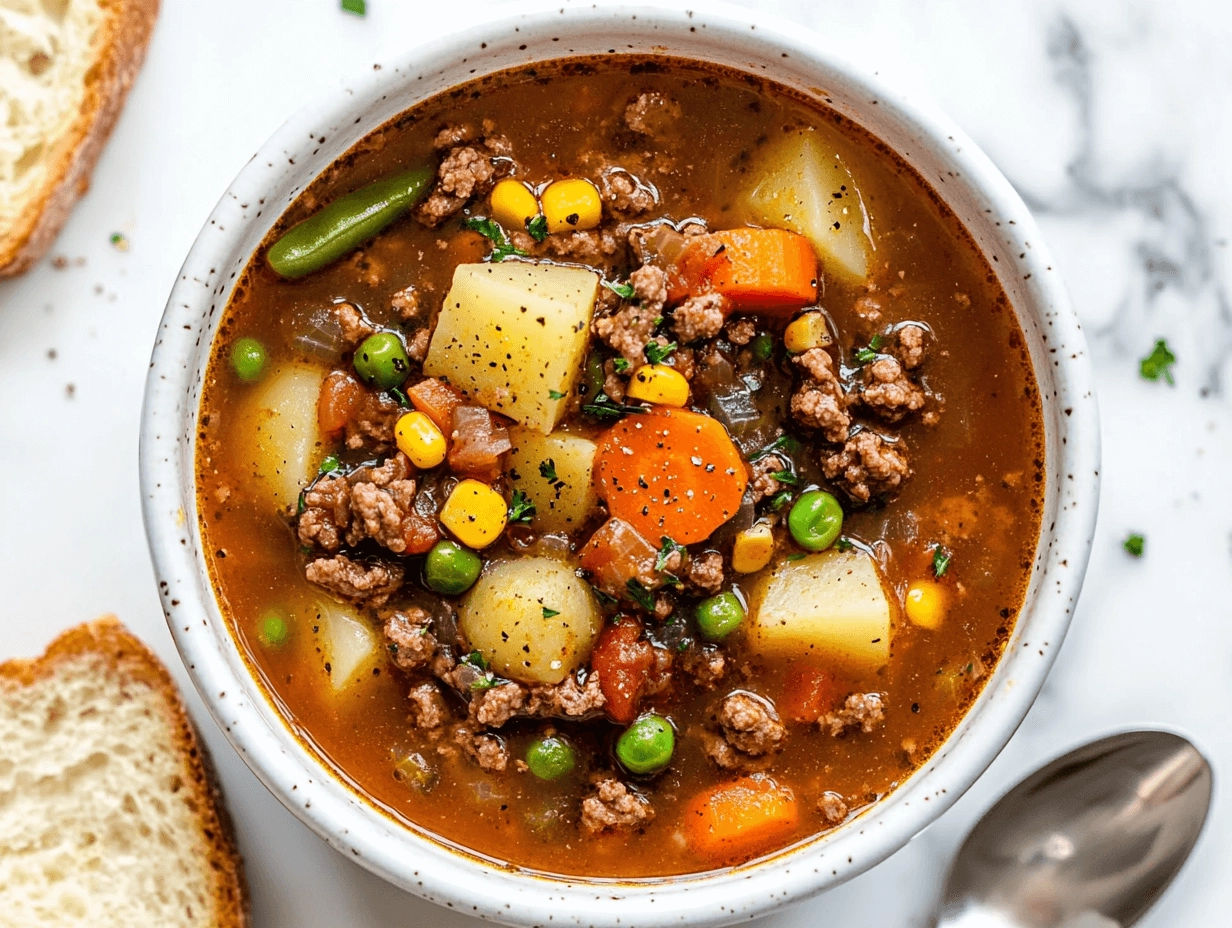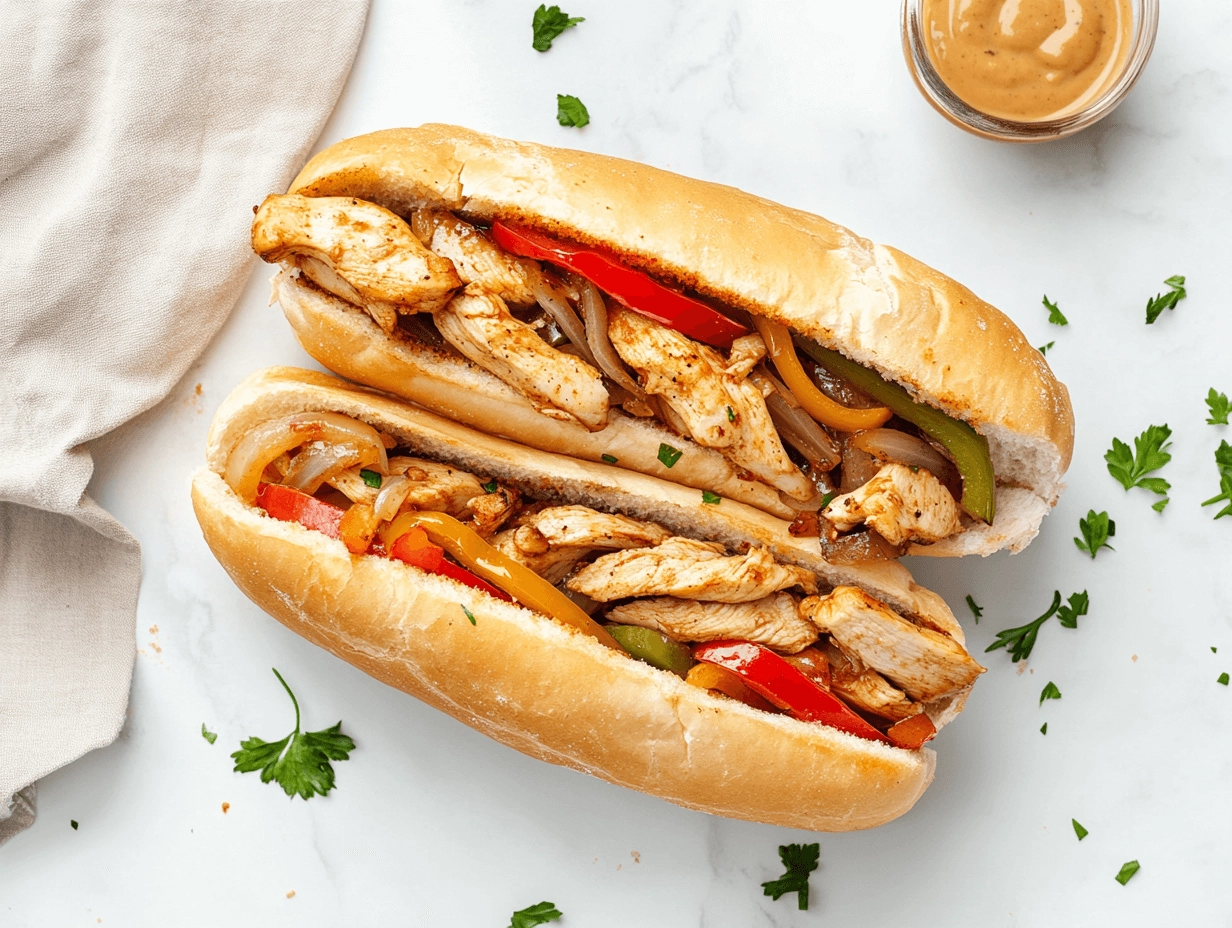Imagine stepping into a bright kitchen filled with the smell of spices and herbs. It feels like you’re in Beirut’s lively streets. Lebanese lunch recipes are more than food; they celebrate culture, family, and Middle Eastern cuisine that brings people together.
Lebanese food is a journey of flavors that goes beyond cooking. Each dish has a story, with fresh ingredients and spices that make lunch special. From meat dishes to vegetarian options, these recipes will change your lunchtime.
Whether you love cooking or just enjoy trying new foods, Middle Eastern cuisine is exciting. The recipes we’ll look at are about more than just eating. They’re about making connections, sharing love, and exploring a rich cultural heritage through food.
Table of Contents
Discover more delicious recipes and ideas by visiting our homepage!
Understanding Traditional Lebanese Cuisine Essentials
Lebanese cuisine is a key part of the Mediterranean diet, known for its rich flavors and healthy ingredients. It connects us to fresh, quality produce and aromatic spices. These elements turn simple meals into unforgettable experiences.
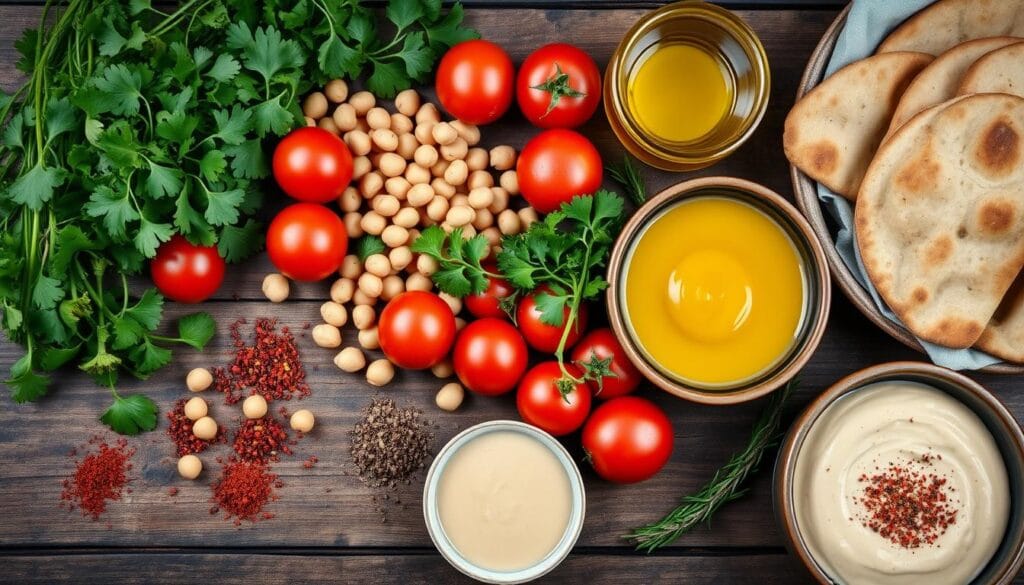
Learning about Lebanese cuisine means grasping its core values of freshness and flavor. It focuses on using whole, unprocessed foods. This approach ensures both nutrition and taste in every dish.
The Role of Fresh Ingredients in Lebanese Cooking
Fresh ingredients are the heart of authentic Lebanese cuisine. Your kitchen should focus on:
- Locally sourced vegetables
- Crisp herbs like parsley and mint
- Seasonal produce at peak ripeness
- Whole grains and legumes
Essential Lebanese Spices and Aromatics
Spices make Lebanese dishes truly special. Zaatar, sumac, and cinnamon add complex flavors. These spices are what make this cuisine unique.
- Zaatar: A blend of dried herbs, sesame, and sumac
- Sumac: Tangy, lemony spice
- Mint: Fresh and cooling
- Cinnamon: Warm and aromatic
The Importance of Olive Oil in Lebanese Dishes
Olive oil is more than a cooking medium in Lebanese cuisine. It’s a key ingredient that connects Mediterranean diet recipes to their roots. Extra virgin olive oil adds heart-healthy fats and deep flavor to dishes.
By embracing these essential elements, you’ll discover the true essence of Lebanese cooking. It’s a celebration of fresh ingredients, bold spices, and cherished culinary traditions.
Quick and Easy Lebanese Lunch Recipes
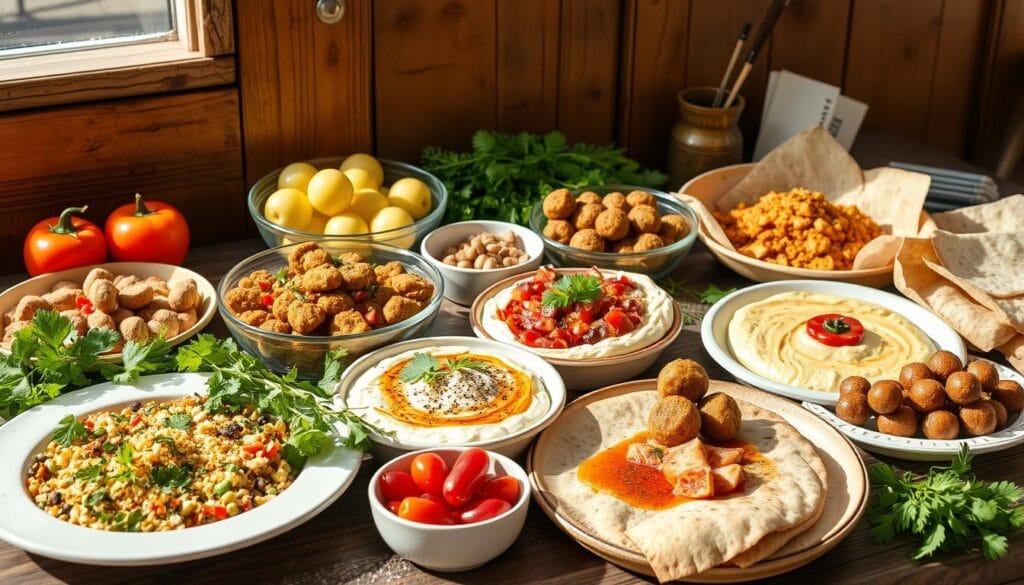
Discovering healthy lunch ideas from Lebanese cuisine is easy. Your weekday meals can change with simple, tasty recipes. Lebanese cooking offers quick, nutritious, and delicious meals.
Lebanese cuisine has many fast options for those looking for healthy lunches. These recipes use fresh ingredients and cook quickly. They are great for busy people who want to eat well.
Top Quick Lebanese Lunch Recipes
- Tabbouleh Salad (15-minute preparation)
- Hummus with Pita Bread
- Lebanese Chicken Wrap
- Falafel Plate
These quick meals bring real Lebanese flavors to your table. They don’t need a lot of cooking skills. The secret is using fresh ingredients and simple methods.
Meal Prep Tips
- Prep ingredients in advance
- Use pre-made hummus for faster assembly
- Chop vegetables ahead of time
- Store dressings separately to maintain freshness
| Recipe | Prep Time | Calories |
|---|---|---|
| Tabbouleh | 15 minutes | 120 kcal |
| Hummus Wrap | 10 minutes | 250 kcal |
| Falafel Plate | 20 minutes | 380 kcal |
Try these quick lunch meals to make your midday meals more exciting and healthy. Lebanese cuisine is a fun way to enjoy nutritious lunches that are easy to make.
Classic Lebanese Rice with Vermicelli
Discover the heart of traditional Lebanese dishes with this classic rice and vermicelli recipe. What is a typical Lebanese lunch? This versatile side dish perfectly captures the essence of Lebanese cuisine, bringing warmth and flavor to your table.

Rice with vermicelli is a staple in Lebanese households. It offers a delightful blend of textures and tastes. The dish combines fluffy rice with golden-brown vermicelli, creating a simple yet sophisticated accompaniment to many meals.
Perfect Rice-to-Water Ratio Tips
Achieving the perfect rice requires precision. Here are key tips for success:
- Use 1½ cups of white rice
- Add 3 cups of boiling water
- Maintain a 1:2 rice-to-water ratio
- Season with 1½ teaspoons of salt
- Add ½ teaspoon of pepper for extra flavor
Variations and Serving Suggestions
Elevate your traditional Lebanese dishes with these creative serving ideas:
- Garnish with toasted pine nuts
- Serve alongside grilled meats
- Pair with fresh yogurt
- Add fresh herbs like parsley or mint
Storage and Reheating Methods
Keep your Lebanese rice fresh with these storage tips:
- Refrigerate in an airtight container
- Consume within 3-4 days
- Reheat gently with a splash of water
- Fluff with a fork before serving
Pro tip: The dish contains approximately 309 calories per serving, making it a nutritious addition to your typical Lebanese lunch.
Hearty Fasolia Bean Stew
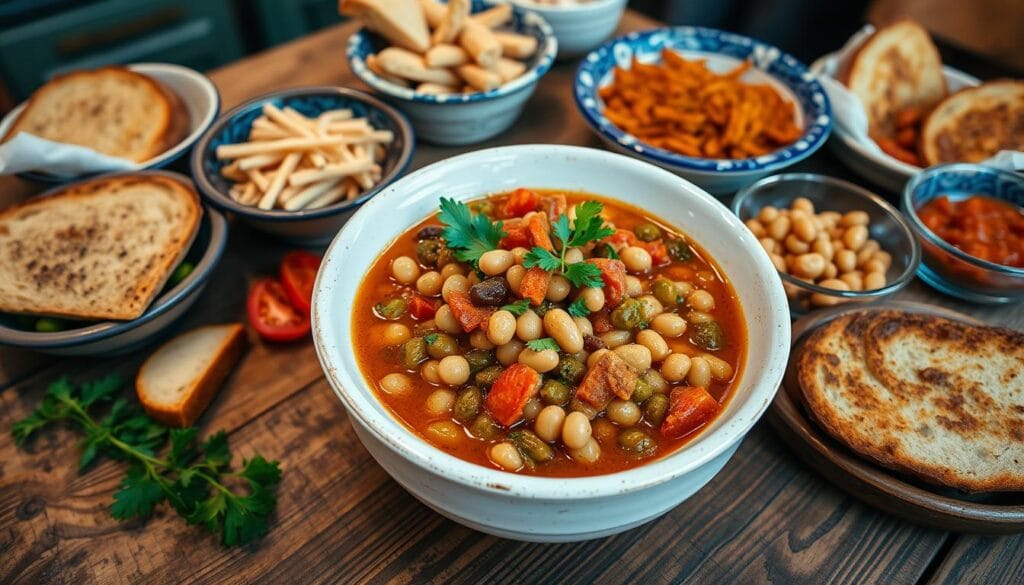
Fasolia is a favorite Lebanese lunch recipe that adds warmth and nutrition to your meals. It’s one of the four traditional dishes from Lebanon, showing the area’s rich food heritage.
The stew has tender beef and green beans in a tasty tomato sauce. It’s a protein-rich meal that’s both delicious and healthy. Here’s why Fasolia stands out in Lebanese lunch recipes:
- High in protein (18g per serving)
- Rich in dietary fiber (14g per serving)
- Low in saturated fat
- Packed with essential vitamins and minerals
To make this authentic Lebanese dish, you’ll need a few key ingredients:
- 1 pound beef, cubed
- 2 cups fresh green beans
- 28-ounce can of crushed tomatoes
- Olive oil for cooking
- Signature Lebanese spices
| Nutritional Information | Per Serving |
|---|---|
| Calories | 301 kcal |
| Protein | 18g |
| Carbohydrates | 57g |
| Fat | 3g |
Pro tip: You can cook this stew on the stovetop or in an Instant Pot. It takes about 30 minutes to cook, making it a quick and fulfilling lunch.
For those who love meal prep, Fasolia keeps well in the fridge for 4-5 days. It can also be frozen for up to 3 months. Enjoy a taste of Lebanon in your own kitchen!
Vegetarian Lebanese Lunch Ideas
Exploring vegetarian lunch options in Lebanese cuisine opens up a world of delicious and nutritious meals. These healthy lunch ideas showcase the rich flavors and traditions of Lebanese cooking. They provide plant-based alternatives that are both satisfying and packed with nutrients.
Lebanese cuisine offers an incredible array of vegetarian lunch options that will tantalize your taste buds. Each dish brings unique flavors and textures. This makes vegan lunch preparations exciting and delightful.
Mujadara Makhbousa (Lentils and Rice)
This classic vegetarian lunch staple combines two simple ingredients into a powerhouse of nutrition. Mujadara Makhbousa features:
- Perfectly cooked brown lentils
- Fluffy rice
- Caramelized onions
- Aromatic spices
Loubia b’zeit (Green Beans in Oil)
A traditional Lebanese green bean dish that epitomizes healthy lunch ideas. Lubiyeh bi Zeit is a vegan lunch recipe with remarkable depth of flavor:
- Fresh green beans simmered for 40-45 minutes
- Seasoned with cumin, paprika, and cinnamon
- Prepared with olive oil
- Can be stored for up to 4 days in the refrigerator
Chickpea and Bulgur Wheat Pilaf
This protein-packed vegetarian lunch combines hearty chickpeas with nutritious bulgur wheat. The pilaf offers a perfect balance of textures and flavors. It will keep you satisfied throughout the day.
These Lebanese vegetarian lunch recipes show that plant-based meals can be both delicious and culturally rich. Your midday meal will never be boring with these incredible options!
Lebanese Street Food at Home
Explore the lively world of Lebanese lunch recipes in your kitchen. Street food is the heart of Lebanese cooking, with quick, tasty meals full of real flavors and traditions.
Trying Lebanese street food lets you travel through taste without leaving home. The U.S. has over 1,000 Lebanese restaurants, with California having more than 100. These places show off the tasty dishes of Lebanon.
Popular Lebanese Street Food Recipes
- Shawarma: Seasoned meat wrapped in soft bread
- Falafel: Crispy chickpea fritters
- Manakish: Traditional flatbread with herbs and cheese
Food lovers can make these favorites at home with easy ingredients and steps. Shawarma, loved in Lebanon, Jordan, and Turkey, has slow-roasted meat and fresh toppings.
| Street Food | Key Ingredients | Preparation Time |
|---|---|---|
| Shawarma | Seasoned meat, flatbread, garlic sauce | 30-45 minutes |
| Falafel | Chickpeas, herbs, spices | 20-30 minutes |
| Manakish | Flatbread, za’atar, olive oil | 15-20 minutes |
Vegan options are easy to find, making Lebanese street food for everyone. With a little practice, you’ll make food as good as restaurants.
Fresh Lebanese Salads and Sides
Lebanese cuisine is full of vibrant, nutritious lunch ideas. Salads are key, adding freshness and flavor to meals.
Understanding Lebanese food’s healthiness starts with their salads. These dishes are rich in nutrients. They use fresh herbs, veggies, and little processing.
Traditional Tabbouleh: A Nutrient Powerhouse
Tabbouleh is a top Lebanese salad, perfect for healthy eating. Here’s why:
- It’s mainly chopped parsley
- Includes ripe tomatoes and green onions
- Has a small amount of fine bulgur wheat
- Is dressed with olive oil and lemon juice
Nutritional Profile of Tabbouleh
Tabbouleh offers great nutritional benefits:
- It has about 259 calories
- 14g carbohydrates
- 3g protein
- Is rich in Vitamin A and Vitamin C
Quick Pickled Vegetables: A Tangy Side Dish
Lebanese cuisine also makes quick pickled veggies. These add zest to meals. Plus, they’re good for gut health thanks to fermentation.
Try adding cucumber for crunch or pomegranate arils for sweetness to your salads. These healthy, vibrant dishes bring Mediterranean flavors to your meals.
Lebanese Lunch Recipes for Meal Prep
Preparing quick lunch meals doesn’t have to be hard. Lebanese cuisine offers tasty and healthy options that are easy to make ahead. With a little planning, you can enjoy real flavors all week, save time, and stay healthy.
Here are some Lebanese meal prep tips:
- Prepare grain-based dishes like mujadara (lentils and rice) that store well
- Make large batches of stews and bean dishes
- Marinate meats in advance for quick cooking
- Chop vegetables and herbs for quick assembly
A standard meal prep falafel bowl can include:
- 6 baked falafel balls
- 1 cup hummus
- 1 cup vegetable salad
- 2 tablespoons fresh herbs
- 1/4 cup Greek yogurt
Keep your Lebanese dishes in airtight containers in the fridge. Most meals last up to 5 days, great for busy people. Remember to keep wet and dry ingredients separate to keep things fresh.
Pro tip: Get good glass containers with tight lids. They’ll keep your meals fresh and easy to take on the go. Your future self will love having these tasty, homemade Lebanese meals ready!
Authentic Lebanese Meat Dishes
Lebanese cuisine is known for its rich meat dishes that add amazing flavors to your meals. These dishes show the skill of mixing spices and cooking methods. They turn simple ingredients into unforgettable meals.
Looking into authentic Lebanese meat recipes opens a world of culinary traditions. These dishes are more than food. They celebrate cultural heritage and family cooking.
Quick Arayes (Grilled Meat-Stuffed Pitas)
Arayes is a favorite street food that combines juicy meat and crispy bread. Here’s why it’s so loved:
- Preparation time: 10 minutes
- Cooking time: 8 minutes
- Servings: 4
- Key ingredients: ground meat, fresh parsley, spices
Lebanese-Style Chicken Wings
These wings are a taste of Lebanese flavor. They have a mix of aromatic spices that will excite your taste buds.
| Ingredient | Quantity |
|---|---|
| Ground Meat | 1 pound |
| Onion | 1 medium |
| Cinnamon | 2 teaspoons |
| Salt | 1½ teaspoons |
Exploring Lebanese dishes, these meat dishes are unique and full of flavor. They are also nutritious, with each serving packed with protein and essential nutrients.
By learning these recipes, you can bring Lebanese cuisine into your kitchen. Each bite shares a story of tradition and family recipes.
Tips for Hosting a Lebanese Lunch Party
Hosting a Lebanese lunch party brings the vibrant flavors of middle eastern food to your home. Creating an authentic lebanese cuisine experience requires careful planning and attention to detail. Your guests will appreciate the thoughtful approach to preparing a memorable meal.
Start by designing a menu that showcases the diversity of Lebanese culinary traditions. Consider these key elements for a successful gathering:
- Create a balanced spread of mezze (appetizers)
- Include a variety of hot and cold dishes
- Offer both vegetarian and meat-based options
- Prepare at least 3-4 different dishes
The art of Lebanese entertaining goes beyond just food. Set the mood with traditional music and create an inviting atmosphere that reflects the warmth of middle eastern food culture. Use colorful tablecloths, brass serving dishes, and ambient lighting to transport your guests to Lebanon.
When serving, embrace traditional Lebanese dining etiquette:
- Serve dishes family-style for sharing
- Encourage guests to mix and match flavors
- Offer multiple small portions instead of large plates
- Provide plenty of fresh bread for dipping
Pro tip: Prepare most dishes in advance to reduce stress and maximize enjoyment. Many lebanese cuisine recipes can be made ahead of time, allowing you to spend more time with your guests.
Mediterranean Diet Benefits of Lebanese Food
Lebanese cuisine is a great way to follow the Mediterranean diet. It’s full of nutrients that help your health. When you look at mediterranean diet recipes, Lebanese food shines as a top choice for healthy eating.
So, why is Lebanese food so healthy? It’s because of its main ingredients and cooking style:
- It uses lots of fresh vegetables and whole grains.
- It focuses on lean proteins like fish and legumes.
- It’s rich in heart-healthy olive oil.
- It avoids processed foods.
Looking for the healthiest Lebanese dish? Many stand out. Tabbouleh and hummus are top choices for their health benefits:
| Dish | Nutritional Benefits | Key Nutrients |
|---|---|---|
| Tabbouleh | Low-calorie, high-fiber salad | Vitamin C, Vitamin K, Antioxidants |
| Hummus | Protein-rich spread | Fiber, Plant-based Protein, Healthy Fats |
| Lentil Soup | Supports heart health | Iron, Protein, Complex Carbohydrates |
The Mediterranean diet, shown through Lebanese food, has big health benefits. Studies show it can cut heart disease risk by 30% and lower inflammation by 15-25%.
By trying Lebanese cooking, you’re not just eating tasty food. You’re also choosing a lifestyle that values nutrition, freshness, and health.
Conclusion
Your journey through Lebanese cuisine is a taste of vibrant flavors and healthy ingredients. It shows us a culture that values fresh, wholesome cooking and sharing meals together. Lebanese lunch recipes are more than food; they open a window into a rich culture.
Lebanese cuisine is incredibly diverse, with everything from hearty stews to refreshing salads. These dishes show how Lebanese cooking balances taste, nutrition, and tradition. It’s not just about cooking; it’s a celebration of fresh ingredients, spices, and family recipes.
Trying out these Lebanese lunch recipes lets you bring a bit of Mediterranean tradition into your kitchen. Whether it’s a quick meal or a big gathering, you’ll see your cooking change. Lebanese cuisine offers health benefits, rich flavors, and cultural depth, encouraging you to keep exploring and improving your cooking skills.
Adding these recipes to your meals means more than just cooking. It connects you to a tradition that values fresh food, balanced nutrition, and sharing meals with family and friends. Your new understanding of Lebanese cuisine invites you to many culinary adventures and enjoyable meals.
FAQ
What makes Lebanese cuisine unique?
Lebanese cuisine stands out for its fresh ingredients and bold flavors. It uses lots of herbs and spices like zaatar, sumac, and mint. This focus on healthy cooking and plenty of vegetables and lean proteins makes it special.
Are Lebanese lunch recipes typically healthy?
Yes, Lebanese lunch recipes are very healthy. They include whole grains, legumes, and fresh veggies. Plus, they use lean proteins and lots of olive oil, following the Mediterranean diet’s principles.
What are some traditional Lebanese lunch dishes?
Traditional Lebanese lunch dishes include Fasolia (bean stew) and Mujadara (lentils and rice). There’s also Tabbouleh (parsley salad) and Arayes (grilled meat-stuffed pitas). Plus, mezze like hummus and baba ganoush are favorites.
Is Lebanese food vegetarian-friendly?
Absolutely! Lebanese cuisine has many vegetarian and vegan options. Dishes like Mujadara, Loubia b’zeit (green beans in oil), and Chickpea and Bulgur Wheat Pilaf are all plant-based and packed with flavor.
How can I make authentic Lebanese rice with vermicelli?
To make authentic Lebanese rice with vermicelli, start by toasting broken vermicelli noodles in olive oil until golden. Then, add rice and broth. Cook until the rice is fluffy and the vermicelli is perfectly integrated, creating a delicious side dish.
What are the key spices in Lebanese cooking?
Key spices in Lebanese cooking include zaatar, sumac, mint, cumin, cinnamon, and allspice. These spices give Lebanese dishes their distinctive, vibrant flavors.
Can Lebanese recipes be prepared quickly?
Yes, many Lebanese recipes are quick and easy. Street foods like falafel, shawarma, and manakish can be made fast. Salads like Fattoush and Tabbouleh are also simple to make, perfect for busy lunches.
How does Lebanese food contribute to the Mediterranean diet?
Lebanese cuisine is a key part of the Mediterranean diet. It focuses on fresh veggies, whole grains, lean proteins, and healthy fats like olive oil. This makes it a great model for healthy eating.
